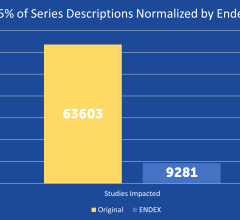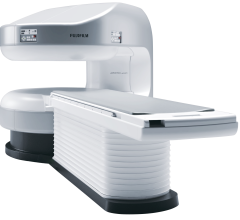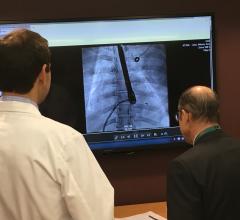LAP LLC announced its Apollo MR3T positioning laser for radiation therapy has received U.S. Food and Drug Administration (FDA) 510(k) approval. The magnetic resonance (MR)-compatible room laser is currently the only product of its class approved the FDA, according to the company.
Global Diagnostics Australia (GDA), a subsidiary of the Integral Diagnostics Group (IDX), has adopted artificial intelligence (AI) applications into its radiology workflow, and is one of the first diagnostic imaging companies in Australia to do so. GDA has partnered with AI company Aidoc to incorporate their algorithms into GDA's care management pathway. These AI applications will expedite patient diagnosis and treatment for several head, neck and chest conditions.
Radiology’s history dates back to 1895 when Wilhelm Roentgen discovered X-rays. The very first image taken was of his ...
Fujifilm’s APERTO Lucent is a 0.4T mid-field, open MRI system addressing today’s capability and image quality needs ...
Help may be on the way for people who might lose contact with reality through a psychotic disorder, such as schizophrenia.
Modus QA is proud to offer the world's first MR-safe Motion QA phantom for simulation, planning and delivery ...

SPONSORED CONTENT — Fujifilm’s latest CT technology brings exceptional image quality to a compact and user- and patient ...
Despite a broad campaign among physician groups to reduce the amount of medical imaging, use rates of various scans have continued to increase in both the U.S. and Ontario, Canada, according to a new study. A recent reacceleration in the growth of imaging concerns researchers because it is widely believed to be overused. The study of more than 135 million imaging exams was conducted by researchers at UC Davis, UC San Francisco and Kaiser Permanente.
SPONSORED CONTENT — Fujifilm’s latest CT technology brings exceptional image quality to a compact and user- and patient ...
New Zealand-based Adept Medical announced the launch of the Antegrade IR Platform. Clinically driven, it is placed to provide an ideal work surface for antegrade femoral approach during interventional radiology vascular procedures. The device sits within the company’s existing range of access and patient positioning devices designed for interventional radiology, cardiology and vascular procedures.
The Webinar "Benefits of Advanced Automation in X-ray" will be presented Wednesday, Sept. 25 at 1 p.m. Central Time ...
Researchers have validated a first-of-its-kind machine learning–based model to evaluate immunohistochemical (IHC) characteristics in patients with suspected thyroid nodules, according to an ahead-of-print article published in the December issue of the American Journal of Roentgenology (AJR). The research team achieved “excellent performance” for individualized noninvasive prediction of the presence of cytokeratin 19, galectin 3 and thyroperoxidase based upon computed tomography (CT) images.
SPONSORED CONTENT — EnsightTM 2.0 is the newest version of Enlitic’s data standardization software framework. Ensight is ...
Researchers in South Korea have found that patients with family and personal history of allergic reactions to contrast media are at risk for future reactions, according to a large study published in the journal Radiology.1 Allergic reactions to commonly used computed tomography (CT) contrast media may be prevented by premedicating patients with antihistamines and using a different type of contrast agent.
Philips will showcase its latest cardiac care innovations at the European Society of Cardiology (ESC) Congress 2019, Aug. 31–Sept. 4 in Paris, France. At the congress, Philips is showcasing Release 5.0 of its Epiq CVx cardiology platform for the first time in Europe. The platform includes automated applications for 2-D assessment of the heart, as well as robust 3-D right ventricle volume and ejection fraction measurements, making accurate exams faster and easier to conduct. Philips also announced that it is collaborating with digital health company LindaCare to combine the latter’s OnePulse cloud-based solution for the remote monitoring of patients with cardiac implantable electronic devices (CIEDs) with the Philips IntelliSpace Cardiovascular informatics platform.
Civco will display its Universal Couchtop ProForm Head & Neck Solution at the 2019 American Society for Radiation Oncology (ASTRO) annual meeting, Sept. 15-18 in Chicago.
Did you know that approximately one-third of all the data in world is created by the healthcare industry and that ...
August 30, 2019 — The CIRS Ultrasound Quality Assurance Portal helps users of CIRS general-purpose ultrasound phantoms ...
In a surprising move, the National Institute for Radioelements (IRE) has applied for a new license to export highly ...

SPONSORED CONTENT — EnsightTM 2.0 is the newest version of Enlitic’s data standardization software framework. Ensight is ...
The clinical needs of those who live in rural America and small communities are both simple and complex. A physician may ...
Beginning with the 2019 meeting, the American Society for Radiation Oncology (ASTRO) will begin transforming its annual ...
Use of the Internet of Things (IoT) is booming, with IHS Markit forecasting there will be 73 billion connected devices in use around the world by 2025. IoT technology has moved beyond speakers and smart fridges and is increasingly being utilized for critical applications across the healthcare industry like insulin delivery devices, connected inhalers and even cancer treatments.
A notable increase in the prevalence of chronic diseases has led to a surge in sales of high-end diagnostic machines, including magnetic resonance imaging (MRI) scanners, which in turn is fostering demand for MRI-safe pulse oximeters, according to a new market report.
Delaware Imaging Network (DIN), Delaware’s largest network of outpatient medical imaging centers, has added NeuroQuant magnetic resonance imaging (MRI) software, to brain imaging studies at all its centers that offer MRI services. NeuroQuant is a U.S. Food and Drug Administration (FDA)-cleared software used in the assessment of neurological conditions.
The University of Alabama at Birmingham, in conjunction with researchers at the University of Wisconsin and Argonne National Laboratory in Illinois, have received a Department of Energy grant to solve a production roadblock for the radioactive isotopes 43Sc and 47Sc. These radioactive isotopes of the metallic element scandium (Sc) appear to be ideal for visualizing and then destroying solid tumors. A barrier, however, blocks their use — the inability to rapidly produce and purify the isotopes in useful amounts. 43Sc has a half-life of 3.9 hours, so every four hours more than half the radioactivity is lost. It must be used in a positron emission tomography (PET) scan the same day it is made.


 September 04, 2019
September 04, 2019 




















